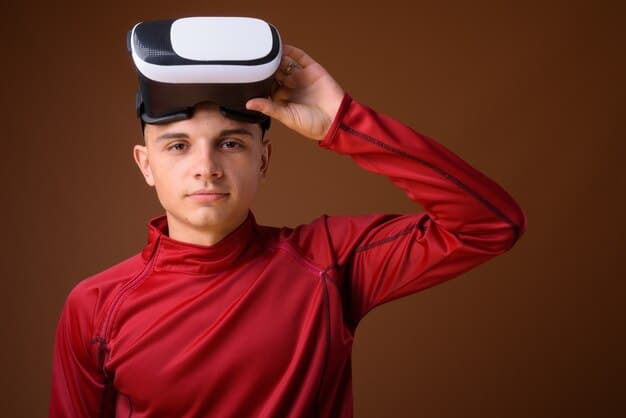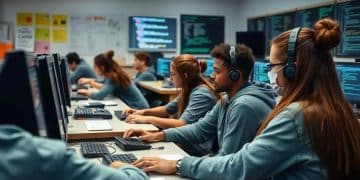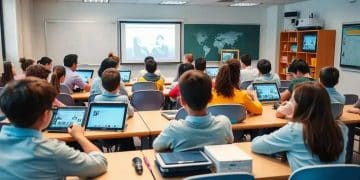VR for Education: Boost Learning Retention by 35% with Immersive VR Field Trips

VR for Education offers immersive virtual field trips that significantly enhance learning retention by 35%, creating engaging educational experiences and making learning more effective.
Imagine your students exploring ancient Rome or dissecting a human heart, all without leaving the classroom. VR for Education: Enhance Learning Retention by 35% with Immersive VR Field Trips is revolutionizing how we teach and learn, offering unparalleled engagement and knowledge retention.
The Rise of VR in Education: A New Learning Paradigm
Virtual Reality (VR) is no longer a futuristic fantasy; it’s a present-day reality transforming numerous industries, and education is no exception. As technology becomes more accessible and affordable, VR is steadily making its way into classrooms, offering immersive learning experiences that can significantly impact student outcomes.
Why VR? The Benefits of Immersive Learning
VR offers a unique ability to transport students to different environments and scenarios, allowing them to interact with content in a way that traditional methods simply can’t match.
- Enhanced Engagement: VR captures students’ attention and keeps them actively involved in the learning process.
- Improved Retention: Studies show that VR experiences lead to better memory retention compared to traditional learning methods.
- Accessibility: VR can provide experiences that would otherwise be impossible, such as exploring space or the human body.

VR in education isn’t just a novelty; it’s a practical tool that has the potential to revolutionize the way we learn. By providing students with immersive and engaging experiences, VR can significantly improve learning outcomes and prepare them for the challenges of the future.
Immersive VR Field Trips: A Gateway to Experiential Learning
One of the most exciting applications of VR in education is the use of immersive virtual field trips. These experiences allow students to explore historical sites, natural wonders, and even microscopic worlds, all from the safety and comfort of their classrooms.
Breaking Down the Barriers of Traditional Field Trips
Traditional field trips can be logistically challenging, time-consuming, and often expensive. VR field trips eliminate these barriers, making experiential learning accessible to all students.
- Cost-Effective: VR field trips are significantly cheaper than traditional trips, reducing the financial burden on schools and families.
- Time-Efficient: No need to spend hours traveling; VR field trips can be completed in a single class period.
- Accessible to All: VR can provide experiences for students with disabilities that might prevent them from participating in traditional field trips.
By offering a practical and accessible alternative to traditional field trips, VR is opening up new possibilities for experiential learning. This allows students to engage with the world in a way that is both educational and entertaining, fostering a deeper understanding and appreciation for the subject matter.
Boosting Learning Retention: The 35% Advantage
The impact of VR on learning retention is one of the most compelling arguments for its adoption in education. Studies have shown that VR experiences can increase learning retention by as much as 35% compared to traditional learning methods. This is due to the immersive and engaging nature of VR, which helps students to form stronger connections with the material.
How VR Enhances Memory and Recall
VR creates a multi-sensory learning environment that stimulates different parts of the brain, enhancing memory and recall.
- Spatial Memory: VR environments provide a strong sense of spatial awareness, which can help students remember information more effectively.
- Emotional Connection: VR experiences can evoke strong emotions, which can further enhance memory and recall.
- Active Learning: VR encourages active participation, which leads to deeper understanding and better retention.

The 35% increase in learning retention is a significant advantage, particularly in subjects where students struggle to grasp complex concepts. By providing a more engaging and memorable learning experience, VR can help students to achieve their full potential.
VR Technology in the Classroom: Practical Implementation
Implementing VR in the classroom requires careful planning and consideration. Schools need to invest in the necessary hardware and software, as well as provide training for teachers on how to effectively integrate VR into their curriculum.
Choosing the Right VR Equipment and Software
There are a variety of VR headsets and software platforms available, each with its own strengths and weaknesses. Schools should carefully evaluate their options to determine which solutions are best suited to their needs.
- Headsets: Options range from standalone headsets to those that require a connection to a computer or smartphone.
- Software: Educational VR software covers a wide range of subjects and learning objectives.
- Training: Teachers need proper training to effectively use VR in the classroom and to guide students through the experiences.
Proper planning and investment are crucial for successful VR implementation. However, the potential benefits of increased engagement and improved learning retention make VR a worthwhile investment for schools looking to enhance their educational offerings.
Overcoming Challenges and Future Trends in VR Education
While VR offers tremendous potential for education, there are also challenges that need to be addressed. These include the cost of equipment, the potential for motion sickness, and the need for appropriate content.
Addressing Concerns and Maximizing Effectiveness
As VR technology continues to evolve, it’s important to address potential challenges and ensure that VR is used effectively in the classroom.
One such challenge is the cost of VR equipment, which can be a significant barrier for many schools. However, as technology advances, and more companies see the potential in the educational sector, this cost is steadily decreasing.
Another concern is the potential for cybersickness, which can occur due to the disconnect between what the eyes see and what the body feels. This can be mitigated by using high-quality VR headsets with low latency and encouraging students to take breaks when needed.
Finally, quality of the content is essential, and educators must critically examine the content they expose their students to, to ensure that it’s appropriate, accurate and educative.
Despite these challenges, the future of VR in education looks bright. As technology improves and costs decrease, VR is likely to become an increasingly integral part of the learning experience. And as more engaging and educative content becomes available, outcomes for students will undoubtedly improve.
VR for Business: The Broader Impact of VR Education
The benefits of VR education extend beyond the classroom. By preparing students with the skills and knowledge they need to succeed in the 21st century, VR education can also have a significant impact on the business world.
Preparing Students for the Future Workplace
VR education can help students develop essential skills such as problem-solving, critical thinking, and collaboration, which are highly valued in the workplace.
VR education can help students develop essential skills such as problem-solving, critical thinking, and collaboration. These abilities are so incredibly valuable in today’s modern and dynamic workplaces, and VR-infused education offers an amazing method to allow students develop them in an immersive and engaging way.
In order to ensure that students are prepared to thrive in the modern working environment, educational institutions must be proactive in embracing technologies that foster engagement, enhance learning and knowledge retention, and make students competitive from the get-go. VR allows all this, and more.
By investing in VR education, businesses can help to create a more skilled and adaptable workforce, driving innovation and economic growth. With VR integrated into both education and training, businesses have the capacity to accelerate learning and develop a team that can meet the needs of the future with confidence and expertise.
The Future is Now: Embracing VR in Education
The potential of VR in education is undeniable. By providing immersive, engaging, and effective learning experiences, VR can transform the way we teach and learn. As technology continues to advance and costs decrease, VR is poised to become an increasingly integral part of the education landscape.
Taking the Next Step: Integrating VR into Your School or Business
Whether you’re a teacher, administrator, or business leader, now is the time to explore the possibilities of VR education. By embracing this technology, you can help to create a brighter future for students and businesses alike. Start by researching the available VR solutions, experimenting with different applications, and engaging with the VR community to learn from others’ experiences. The future of education is here, and it’s virtual.
| Key Point | Brief Description |
|---|---|
| 🚀 Enhanced Engagement | VR actively involves students in the learning process. |
| 🧠 Improved Retention | VR experiences lead to better knowledge retention. |
| 🌍 Accessible Learning | VR provides impossible learning experiences. |
| 💸 Cost-Effective | VR is cheaper than traditional field trips. |
FAQ
▼
VR for Education uses realistic simulations and virtual environments to create immersive learning experiences, making complex subjects easier to understand and more engaging for students.
▼
VR enhances learning retention by providing realistic and immersive environments that encourage active learning and emotional engagement, creating stronger neural pathways that make recall easier.
▼
Subjects that are complex or difficult to visualize, such as anatomy, history, and physics, benefit most from VR, as it allows students to explore these concepts in interactive and intuitive ways.
▼
Yes, VR education can be adapted to cater to various learning needs and abilities, ensuring that all students can participate and benefit from the immersive experiences. This also includes disabled students who may be unable to attend regular excursions.
▼
VR implementation requires headsets and supporting software. While costs can be prohibitive, prices will eventually decrease as the technology continues to evolve and improve over coming periods,.
Conclusion
In conclusion, VR for Education: Enhance Learning Retention by 35% with Immersive VR Field Trips isn’t just a technological novelty; it’s a pivotal advancement in pedagogy. By providing immersive, engaging, and effective learning experiences, VR has the incredible potential to transform education for today’s students.





